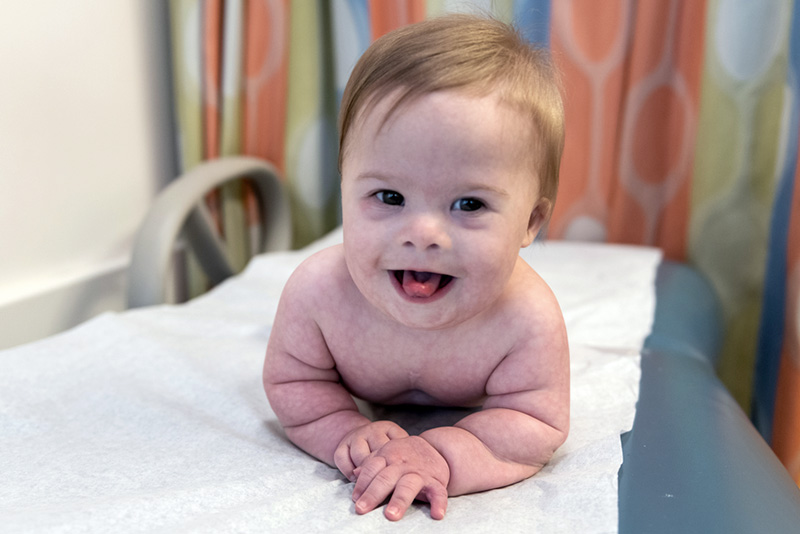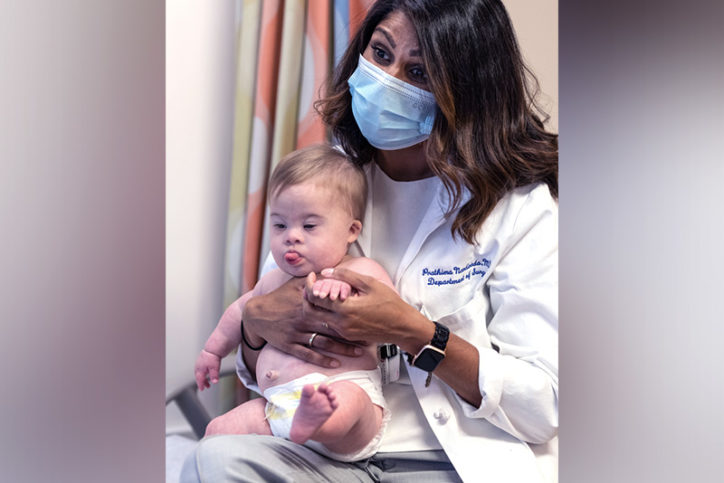Hirschprung’s disease won’t stop Myles from smiling

Looking at Myles today, you’ll see a picture-perfect 1-year-old full of smiles and giggles. He babbles like any other baby and has a lot of energy that keeps his parents on their toes. You wouldn’t know that the past 12 months have held a series of surprises for his parents — and life-changing treatment for him. Doctors at his birth hospital initially expected him to be born with his intestinal organs on the outside of his body, a condition known as omphalocele. “We were prepared for him to be born with this condition and to be immediately swept away for surgery,” remembers Amanda, Myles’ mom. “But when he finally arrived, he had everything where it was supposed to be, which was a huge relief.”
But this relief was soon replaced with a new worry — Myles wasn’t pooping for the first few days after he was born. After a few trips to the emergency department of his local hospital at just 4 days old, Myles was diagnosed with Hirschsprung’s disease. This condition occurs when a baby’s intestinal nerve cells don’t develop properly, delaying the progression of stool (poop) through the intestines. This leads the intestines to become blocked, leaving children unable to feed and at risk for a life-threatening intestinal infection called enterocolitis.
Trust goes a long way
When he was 4 weeks old, Myles and his family traveled from their home in Manchester, New Hampshire to meet Dr. Prathima Nandivada, a surgeon in the Colorectal and Pelvic Malformation Center at Boston Children’s, after being referred to her. It was evident to Dr. Nandivada, upon meeting Myles for the first time, that something was seriously wrong. “We brought Myles to meet Dr. Nandivada on a Tuesday afternoon, and by that night, he was admitted into the NICU (Newborn Intensive Care Unit),” remembers Amanda. “She was able to recognize that Myles needed surgery immediately, after just meeting him that day.”
Dr. Nandivada knew Myles needed a colostomy, a procedure where an area of the colon is brought out to the surface of the belly and stitched in place. A colostomy bag is then placed on the outside of the belly to collect stool.

Myles had his colostomy bag for seven months before undergoing a pull-through procedure to remove the blocked section of intestine. To help ease their nerves about surgery, Dr. Nandivada walked Amanda and her husband through everything that was going to happen before Myles went into surgery and even shared pictures of Myles’ operation, post-surgery, to show what happened while they were operating. “Those little details of just being there for us and sharing those intimate details, as parents, it was so thoughtful and appreciated,” shares Amanda. “Dr. Nandivada’s confidence and experience really lifted a huge weight off our shoulders.”
Better days ahead
After the successful pull-through, Myles had six inches of intestines removed to help clear the blockage. And one month later, Dr. Nandivada was thrilled to see that Myles was healing at a level that she expected to see at the one-year follow-up.
When asked what advice she would give to families who may be experiencing a similar diagnosis and situation, Amanda stresses the importance of trusting your child’s care team and avoiding searching symptoms up on the internet. “You can really fall down a hole of misery if you keep Googling possible diagnoses,” explains Amanda. “It’s best to trust your child’s medical team, to turn to internet groups to connect with other families and share resources, and to always keep your child’s best interest at the top.”
Now, after celebrating his first birthday last month in an apple orchard, Myles is ready to take on the world. He spends his time playing with his new keyboard, watching silly videos on his mom’s iPad, and visiting his grandparents for sleepovers. “He’s all smiles all the time — he’s perfect.”
To learn more, visit the Colorectal and Pelvic Malformation Center
Related Posts :
-

Treatment for anorectal malformation gives Steven freedom and confidence
Steven York has “come a very long way,” says his mother, Beth — both literally and figuratively. In just seven years, ...
-

Laparoscopic approach to cloacal malformation repair found safe in eligible patients
A minimally invasive surgical approach called laparoscopic rectal mobilization and urogenital separation appears to be a safe alternative to open ...
-

Urodynamics testing: What to expect
If your child has been diagnosed with a colorectal or pelvic malformation, they may also experience urological problems such as ...
-

Amazing Grace: Toddler receives life-changing care for cloacal anomaly
Grace Brown loves playing with her six brothers and sisters, watching educational TV shows, and just being an average toddler. ...





